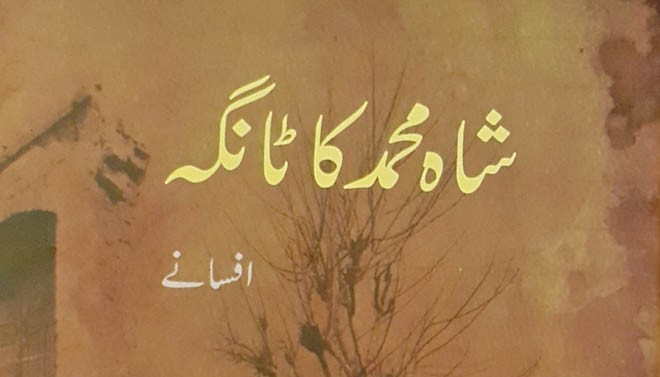
Combine an unstoppable talent for storytelling with an acute sense of social injustice and you get the recent collection of short stories by Ali Akbar Natiq

Shah Muhammad Ka Tanga is Ali Akbar Natiq’s second collection of short stories. The first collection, Qaim Deen, was published by Oxford University Press, Pakistan. Qaim Deen was translated into English by Ali Madeeh Hashmi as What Will You Give for This Beauty? and published by Penguin Books India.
This book, though titled Shah Muhammad Ka Tanga, is a dynamite of sorts. These stories have already appeared in Hindi and English under the same title by Juggernaut, a publishing house established by Chiki Sarkar, who formerly managed Penguin Random House India. In Pakistan, Sanjh publications has taken the brave step of publishing these stories despite their scandalous content but it is indeed a laudatory attempt at highlighting the contradictions of our society.
Ali Akbar Natiq is so many things in one person: trained mason, writer, poet, university teacher, and, above all, a good dastango in the old sense. He can tell stories after stories over a cup of tea and it is difficult to guess where fiction begins or truth ends.
This reviewer has often wondered after many such baithaks about his storytelling ability that Natiq has become his craft. He is a compulsive storyteller, and if truth needs to be ignored to create a good story he is happy to let the story flourish. The stories included in this book are very readable and often have the flavour of yarns told in old caravanserais to weary travellers. Combine this almost unstoppable talent for storytelling with an acute sense of social injustice and structural violence and you get Shah Muhammad Ka Tanga.
Moreover, Natiq has displayed a sense of fearlessness that other writers can only dream of. His characters, like the madmen in the short story ‘Naslain’ (Generations), do crazy things but the surprising thing is that their actions seem logical in light of what we as a nation have been doing to ourselves.
Natiq’s stories ask great sociological questions: If there are two daughters of a haji who make moonshine at home and earn good money for their father, why would the haji marry them off? If a young boy is going to remain poor and experience freezing temperatures in December nights while trying to remain moral, how long will it take for the moral universe to crumble and turn the boy into a catamite hustling for a sweater?
The ultimate question is: why is there nothing ever mainstream and blasé in Natiq’s stories?
The answer lies partially in Natiq’s biography and partially in the contradictions of our society. How can a society that has fighter planes as public art, pistol-toting guards outside every bank, burqa-clad ladies flaunting Gucci bags and designer amulets, supermodels being charged of money laundering, and mullahs running elitist fashion labels, have "normal" characters left?
Natiq’s characters are logical outcomes of our social arrangements. This can be argued in another way: is it normal that the General who hyper-Islamised Pakistan had also contributed to the death of thousands of Palestinians as a Brigadier in Black September?
If a society displays all the signs of collective madness, a writer who creates normal and well-adjusted characters does not study their society seriously.
So here we have, in the form of Natiq, everything that the society does not want to look at: wine-making daughters, young gigolos pleasing elderly men for winter clothing and money, onanists hell-bent on defiling monuments of national importance, spiritual guides who advise human sacrifices, labourers grinding the carbon rods taken out of zinc-carbon batteries to turn them into hair removal powder, and village hooligans fighting each other because social images of masculinity must be upheld.
All of these crooked characters and powerful narrative surprises make the book pleasant because one can finally see a diagnosis that is as convoluted as the object of diagnosis.
As far as the art of the short story is concerned, there are not many experiments at the linguistic level (those are to be found in Natiq’s poetry). This creates a new kind of transparency in the language employed to tell the story. The reader does not have to pay any attention to the language. This does not mean that Natiq is not a stylist. He displays his talent for creating a suitable "voice of the narrator" in the short story ‘Delhi Ka Muraqaa’ and ‘Naslain’. In the former, he has created a sketch of Delhi using the diction appropriate for the era and Persianised aesthetics of Mughal opulence. In the latter, Natiq has done something even more remarkable. He has written the diary of a madman who lost his sanity because his relatives became victims of extremism in the rambling style of a paranoid schizophrenic person.
‘Naslain’ is the most surreally disturbing story in the entire collection. Natiq has managed to do something that Foucault also attempted to do: to be rational enough to analyse madness and to be mad enough to analyse reason.
It is, perhaps, a blessing for the readers of Urdu fiction that Natiq manages to remain an outsider for the literary establishment because of his abrasive demeanour in everyday life and a very creative relationship with socially accepted truths. This ensures he will not be a co-opted and keep on producing uncomfortable literature for a long time to come. Finally, the Urdu language has its own Jean Genet.